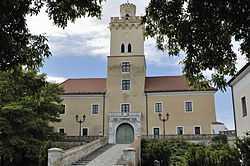Dürnkrut, Austria
| Dürnkrut | ||
|---|---|---|
 | ||
| ||
 Dürnkrut | ||
| Coordinates: 48°28′N 16°51′E / 48.467°N 16.850°ECoordinates: 48°28′N 16°51′E / 48.467°N 16.850°E | ||
| Country | Austria | |
| State | Lower Austria | |
| District | Gänserndorf | |
| Government | ||
| • Mayor | Herbert Bauch | |
| Area | ||
| • Total | 30.4 km2 (11.7 sq mi) | |
| Elevation | 161 m (528 ft) | |
| Population (1 January 2013)[1] | ||
| • Total | 2,254 | |
| • Density | 74/km2 (190/sq mi) | |
| Time zone | CET (UTC+1) | |
| • Summer (DST) | CEST (UTC+2) | |
| Postal code | 2263 | |
| Area code | 02538 | |
| Website | www.duernkrut.at | |
Dürnkrut (Slovak: Kruta, Suchá Kruta, Czech: Suché Kruty) is a town (market town German: Marktgemeinde) in the district of Gänserndorf in the Austrian state of Lower Austria. The Castle Dürnkrut (pictured) is the well known icon of the town. The town is largely agricultural with several noteworthy businesses. Crops grown in the flatter areas are Raps, Corn, Sunflowers and Sugar Beets. The rolling hills are planted with wine grapes by several local wine makers.
Dürnkrut is located on the March river (border with Slovakia) which occasionally floods. The last major flood was in 2006 when many houses closer to the river were flooded with 2 metres of water[citation needed]. Dürnkrut is located on the Austrian Railways Nordbahn line. In former times there was a large sugar factory that processed the sugar beets into refined sugar. It closed down many years ago, but some of the buildings still remain. The wine cellar street has many old wine cellars.
To sister town of Waidendorf is located 2 km away, and has even more focus on agriculture.
Subdivisions
- Dürnkrut
- Waidendorf
Nearby municipalities
- Gajary (German: Gayring, Hungarian: Gajar)
- Götzendorf, Velm-Götzendorf
- Jedenspeigen
- Waidendorf
- Angern an der March (Slovak: Congr)
- Zistersdorf (Slovak: Čistejov)
See also
- Battle on the Marchfeld (also known as "Battle of Dürnkrut")
